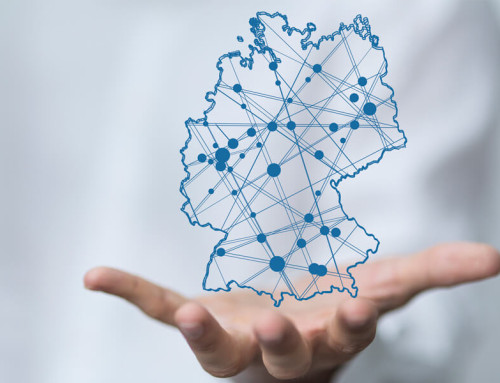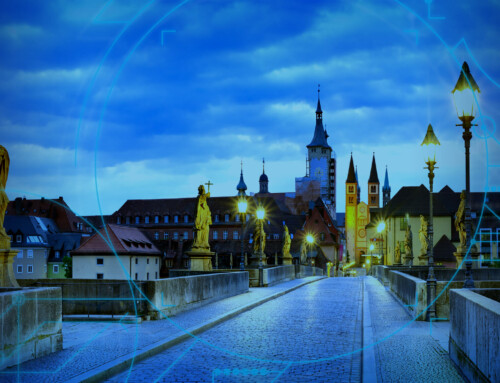I am happy to announce that the German tourism industry’s biggest ever data infrastructure project is now live! Today, in conjunction with all project participants, we finally brought the GNTB Knowledge Graph on stream. Over the past three years, we have put in a lot of hard work – and shown great agility and vision – in order to get this collaborative project up and running. At this point, I would like to thank my team and all the various partners, the 16 regional marketing organisations for the federal states, the Magic Cities marketing association, the travel technology company Amadeus, the German Convention Bureau, representatives from academia and other tourism partners. My thanks also go to all those who have provided funding and other support for this project, above all the Federal Ministry for Economic Affairs and Climate Action. Now that the Knowledge Graph has gone live, the critical phase of creating new business models begins. The digital guest in the digital destination will be better informed and will be able to make their trip smoother, more memorable and more sustainable. I would like to take today’s launch of the Knowledge Graph as an opportunity to share some thoughts on the current state of play, the positioning and the tasks that lie ahead.
1. Strategic positioning
The GNTB is contributing to key areas of action in the German government’s data strategy through the project. It is putting in place high-performance, sustainable data structures, it is making data use innovative and responsible, it is improving data literacy and it is establishing a data culture. The project, part of the German government’s national tourism strategy, will be pivotal to the process of digital transformation in Germany, particularly for the tourism industry and its predominantly SME businesses. By launching the Knowledge Graph, we have successfully brought the tourism industry’s biggest ever data infrastructure project to fruition. The sharing of data across organisations, federal states and industries using this kind of system can already be seen as a pioneering achievement within the German economy. It is also sending a clear signal as to the innovative capabilities of our sector.
2. Key challenges
Digital touchpoints already feature throughout the customer journey – from the initial inspiration via virtual reality, the research, planning and booking stage (e.g. with the aid of conversational interfaces), to the travel experience itself, with traveller IDs, digital guest cards and real-time management of visitor flows to smooth out peaks during the high season. Digital analysis and the profiling of travellers, on the other hand, are facilitating the development of products for future trips and enabling capacity to be planned in line with demand. And those are just some of a long list of current and potential applications. The proportion of bookings made online by our international guests has gone up from just under 70 per cent to nearly 90 per cent over the past decade. So it is all the more important for destinations to ensure that their data is included on the digital platforms and services where these bookings are made. The digital transformation is progressing in ever shorter cycles. It took social media platforms such as Facebook and Instagram years to become established, for example, whereas technological innovations such as OpenAI’s chatGPT have secured significant market penetration within a matter of weeks. Competitors have recognised this too. The number of AI-supported applications, whether for processing text, generating images or providing customer service, is growing on what seems like an hourly basis. Of course, you can’t just install AI like an Office programme and leave it to its own devices. To make the most efficient and effective use of AI, we need to have at least a basic grasp of how AI-supported applications work and what the algorithms and learning mechanisms are actually doing.
3. The status quo in June 2023
The Open Data project is our response to the supply- and demand-led disruption of the travel market worldwide. It is enabling us and our partners to tap into the commercial potential of tourism-related data using AI applications. It should be kept in mind here that the flow of data is more important than the channel used to transmit it. What matters most for the user is that the data they need actually reaches them. The paths it takes are, for them, immaterial. By focusing our strategy on digital technologies, we are securing the competitiveness of Destination Germany in the international market. Now that the Knowledge Graph has gone live, all stakeholders – from global sales platforms and tourism service providers to start-ups – have access to more than 200,000 up-to-date and high-quality data sets that are generally available for download. These data sets – as things stand – cover 100,000 tourism assets (POIs, tours, events, restaurants, cafés, hotels etc.) and a further 100,000 infrastructure components. Drawing on tourism data from all 16 federal states, the Knowledge Graph serves as a central database for Germany’s tourism industry. Other project partners include the Magic Cities marketing association, travel technology company Amadeus, the German Convention Bureau and representatives from academia. The technical infrastructure put in place so far also offers many other partners in both the public and private sectors the opportunity to seamlessly link their reservoirs of data to the Knowledge Graph via their regional marketing organisation.
4. The potential today
A key asset of the Knowledge Graph, besides actually collecting the data in one place, lies in ensuring that the data is structured, licensed, integrated and made accessible in an enhanced form. Data of this unprecedented quality, which is available to all market players, means that even less well-known tourism offerings are able to be found by AI applications. This will allow SMEs and start-ups to develop their own intelligent, customer-centric services and secure a foothold for them in the market. The Knowledge Graph provides a basis for developing innovative applications that utilise the power of AI. Such an application might analyse, forecast and manage visitor flows, for example, helping to avoid congestion, relieve the pressure on tourism hotspots during peak times, protect sensitive natural habitats and ensure a better quality of stay. We can use open data to which semantic meaning has been added to accelerate the learning capabilities of voice and other virtual assistants. The number of these virtual assistants is already growing at an exponential rate. From the navigation systems found in cars to the self-learning chatbots used in customer service hotlines, conversational interfaces are increasingly becoming the norm in more and more parts our lives. The effects are also being felt in the world of work. The shortage of skilled workers will likely only get worse thanks to demographic change. But if AI-driven systems are able to take on routine tasks on a 24/7 basis, skilled employees will be able to spend more of their time on specialist or complex tasks.
5. Open data is a collaborative matter
At the go-live, the Knowledge Graph presents itself as a federal project coordinated by the GNTB and supported by all federal states. To mark the occasion of the go-live, the managing directors of the 16 regional tourism organisations have reiterated this commitment.
6. Next Steps
I cannot stress highly enough that today’s launch should be seen as a milestone in our digital journey, not the end point. The associated technological leap will enable us to open up more and more content-based dialogues with the guest at increasing numbers of touchpoints. To achieve this, we have set out key tasks for the GNTB over the coming weeks and months. And we are not alone. Many tourism partners have also recognised the opportunities and challenges presented by the project and are forging concrete plans for their own next steps. I am pleased to be able to share with you here some of the initiatives that are planned and what they will be doing with the data. Meanwhile, we at the GNTB will be redoubling our efforts on the data distribution side by building and expanding contacts to potential data users. Rail services are also planning to provide data for the Knowledge Graph, which will help others to improve their services along the customer journey. And by promoting train travel as a climate-friendly transport option, we are clearly addressing the need to make tourism in Destination Germany more sustainable. We will also be using data from the Knowledge Graph to train our AI-assisted chatbot Anja at www.germany.travel.
7. A look ahead to the future
The Knowledge Graph facilitates a level of innovation that extends far beyond the day-to-day business of the tourism industry. Among other things, this is drawing back the curtain on the increasingly close relationship between a destination’s appeal from a tourism perspective and its appeal as a centre of commerce and industry. In an increasingly agile and mobile world of work, digital nomads are already leading the way here. On the academia and research side, open data and the interoperability of the data model will allow stakeholders to use tourism data to develop and implement visitor management systems. This data is also a boon for the design of smart cities. We are already engaged in intensive dialogue at various levels, and the networks we are building to this end are growing steadily in both reach and granularity. Going forward, we will need to engage in closer dialogue with representatives from academia and with others such as the chambers of industry and commerce in order to initiate appropriate training programmes and set up research projects. The question of data sovereignty is often brought up in this context. Here too, the Open Data project can be seen as a positive development. After all, the destinations and service providers at the various levels retain control over their own data and content and can still use it for their own purposes. They decide how the data is collected, stored, processed and used. This gives them greater autonomy over the delivery of services and/or offerings that are based on their data and over the visibility of their own products and services. The portability of the data is a closely related topic. Having an independent data management tool means that data can be transferred much more easily between different systems, platforms and applications. The destinations are therefore able to move their data from one service provider or product vendor to another or to put it to use in other spaces, such as smart city projects, without loss or restriction. This gives them the freedom to choose service providers and distribution channels that will make best use of their data in related areas and prevent them from becoming overly reliant on individual providers. It will also be important to link up with the many digital projects at European Level such as the European Data Space for Tourism (DATES). Technological innovations in data management go hand in hand with criteria such as data protection, data sovereignty, data ethics and data culture. The launch of the Open Data/Knowledge Graph project is a milestone in making international tourism – and therefore inbound tourism to Germany – sustainable, competitive and fit for the future. The regional marketing organisations are also telling us about projects that make specific use of the Knowledge Graph and that are set to be implemented over the course of this year. Here are some examples from our project partners in the federal states:
Bavaria:
Barbara Radomski, Managing Director of Bayern Tourismus Marketing GmbH
“We will soon have access to a range of sensor data that can deliver real-time information about capacity utilisation and facilitate forecasts. We are also working on attractive modules, covering aspects such as winter sports and events, that will enable us to offer our guests the best possible information. Services via BayernCloud Tourismus, including widgets that provide a website construction kit and a bespoke app, will add value by making the best use of the available information.”
Baden-Württemberg:
Andreas Braun, Managing Director of Tourismus Marketing GmbH Baden-Württemberg
“We are currently looking at how AI can simplify data management in our mein.toubiz system, and are continuing our training programme of webinars, discussions and specialist seminars on legal matters. We hope this will dispel any doubts, enable us to keep any barriers to adoption to a minimum and encourage those responsible for data to make it available. One way of achieving this is by including topics that are relevant and current in our database, such as mobility, sustainability and accessibility.”
Hessen
Herbert Lang, Head of Tourism, HA Hessen Agentur GmbH
“This year, we will be rolling out our content hub as part of the modular Tourismus-Hub Hessen, a central database for all non-bookable tourism information from Hessen’s ten main destinations. The technology allows the various players to collate and link tourism-related data, such as content on points of interest, places to visit and places to eat, and make it available in one central location. Data from across Hessen is pooled in the content hub, either by entering it directly or via an interface with an existing destination database system. The graph-based database allows for the information to be passed on to the GNTB’s Knowledge Graph.”
Lower Saxony
Meike Zumbrock, Managing Director of Tourismus Marketing Niedersachsen GmbH
“We plan to link more databases – including TOMAS for accommodation providers, plus experiences and guided tours – in order to expand our range of data. We are also looking into linking open-data content from the Niedersachsen Hub via the Knowledge Graph with data sets that are not directly related to tourism, such as traffic and infrastructure data, real-time geo data, public transport timetable information, parking space availability, POI capacity, information on nature conservation areas, real-time water quality and levels, air quality and more. This will establish the Knowledge Graph as the central repository for tourism-related open-data content in Germany, and enable many useful applications that offer added value for visitors.”
North Rhine-Westphalia
Dr. Heike Döll-König, Managing Director of Tourismus NRW e.V.
“We aim to improve the quality of the data in the Data Hub NRW by the end of the year by adopting the standards of the Open Data Tourism Alliance and tightening our quality criteria. Working with data users, we will identify new use cases and develop innovative solutions. We will also press ahead with skills training in order to promote a broad data mindset across the North Rhine-Westphalia tourism landscape. Adding sustainable travel experiences and transport options will also allow us to further customise and expand our tourism offering.”
Saxony
Veronika Hiebl, Managing Director of Tourismus Marketing Gesellschaft Sachsen mbH
“We have launched a new ‘Open Data Offensive’ format with our DMOs to support the transfer of knowledge and the implementation in collaboration with data managers across Saxony. The two-hour webinar was launched in May as a joint event with Tourismusverband Erzgebirge, and we now plan to roll it out to other regions in Saxony. We are also working on expanding the stationary and mobile use cases for our SaTourN system. In May, two further output channels from Leipzig Tourismus und Marketing GmbH were added to SaTourN, the state-wide digital architecture for tourism data in Saxony. These two digital information terminals and a number of displays in Leipzig’s main train station and the refurbished tourist information office provide travellers with recommendations and information on places of interest, offers and events for their stay in Leipzig. The data relating to Leipzig is delivered to a progressive web app via the SaTourN system and displayed in German and English at the information points and on the displays.”
Thuringia
Christoph Gösel, Managing Director of Thüringer Tourismus GmbH
“With the help of funding from Thuringia’s State Chancellery, we have established three interactive digital exhibitions – one in Weimar, one at Wartburg Castle and one as part of the German National Garden Show in Erfurt – to provide information about leisure activities in Thuringia. The exhibitions use data from ThüCat and thematic links to promote Thuringia’s tourism hotspots in an engaging way. They have been designed to inspire visitors and locals to explore more of Thuringia. After its stint at the German National Garden Show, the exhibition in Erfurt will move to Altenburg. The modular construction of the stands ensures that their use is sustainable.”
International
As a member of the Open Data Tourism Alliance (ODTA), the GNTB is stepping up its international dialogue aimed at developing further common tourism data standards. Three national tourist organisations and 20 partners at federal level are already on board. The ODTA uses the experiences we have gained from our use cases, among other things, in its work on data ontology. This ensures that the data standards needed in tourism are continuously refined and submitted to the schema.org consortium by the ODTA.
8. Conclusion
The delivery of the Open Data/Knowledge Graph project is of huge significance from a political, economic and technological perspective, and also in respect of more sustainable forms of tourism. We have put ourselves on the right track for the future with our launch today. It is now a question of gaining momentum so that Destination Germany can continue to stand strong in the international market for many years to come.

Petra Hedorfer
Chairwoman of the GNTB












